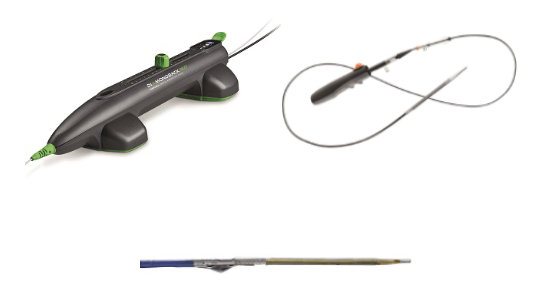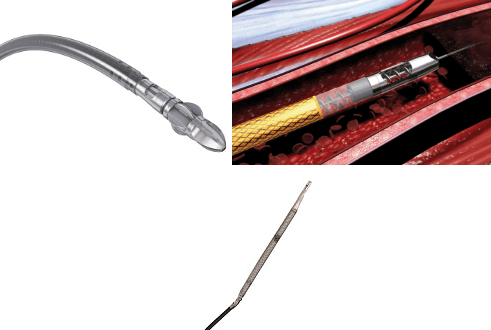The removal of plaque from peripheral arterial lesions is often needed when preparing vessels for adjunct therapies such as drug-coated balloons and drug-eluting stents. In addition, recent positive results with drug-coated balloons in the superficial femoral artery have generated enthusiasm in calcium removal technologies. Following the presentation of results from the DEFINITIVE AR trial in April 2015, the Charing Cross Symposium audience voted in favour (77%) of the use of atherectomy in long and calcified lesions as pretreatment of superficial femoral artery lesions before drug-coated balloon implantation. Recently Medtronic announced a new study (REALITY) to evaluate patient outcomes following adjunctive use of directional atherectomy and drug-coated balloon in long, calcified lesions in the superficial femoral artery and/or popliteal artery. Atherectomy can also be an important stand-alone tool in areas where drug-eluting balloons and stents have no proven efficacy, according to Thomas Zeller, Bad Krozingen, Germany. Vascular News has gathered some of the different plaque removal technologies currently available on the market.

![]()
Diamondback 360 (CSI)
The Diamondback 360 device is an orbital atherectomy system used to treat peripheral arterial disease above and below the knee that uses a diamond-coated crown, attached to an orbiting shaft, which sands away plaque while preserving healthy vessel tissue.
The Diamondback portfolio has been expanded with a 4F profile catheter for use in tibioperoneal lesions, with potentially fewer bleeding complications and reduced closure time. Diamondback 360 is currently available with three unique crown designs in multiple sizes and varying lengths.
The CONFIRM series (I, II, III) is the largest real-world peripheral arterial disease registry, having enrolled 3,135 patients at over 200 hospitals over the course of the three trials. Results showed consistent safety and efficacy in real-world patient populations. Across the three studies, the rate of bail-out stent due to dissection was 5.8% or lower, perforation rate was 0.9% or lower, abrupt closure rate was 1.4% or lower and embolisation rate was 2.2% or lower. Other trials—covering both above- and below-the-knee vessels—include OASIS, CALCIUM 360, COMPLIANCE 360, TRUTH and CLARITY, all of which indicate the safety and efficacy of the Diamondback 360.
The LIBERTY 360 trial—a prospective, observational, multicentre post-market study—is currently enrolling up to around 1,200 patients who will be followed-up out to 60 months at 100 US sites.
The Diamondback 360 system has received CE mark and US 510(k) clearance, and is currently available in the USA.
HawkOne (Medtronic)
The HawkOne device is the latest addition to Medtronic’s directional atherectomy portfolio, which restores blood flow in peripheral arterial disease patients by removing plaque from blocked arteries. The HawkOne device allows physicians to treat all morphologies, including severe calcium, and offers procedural efficiency with enhanced cutting, crossing and cleaning capabilities.
Crossing and cleaning enhancements streamline procedural efficiency. The HawkOne device is a 7F platform, which allows for more predictable crossing of challenging lesions. The cleaning process has been simplified so there are fewer steps, saving valuable lab time.
The HawkOne is both CE mark- and FDA-approved.
The device is being investigated in combination with drug-coated balloons in the REALITY (Directional atherectomy and drug-coated balloon to treat long, calcified femoropopliteal artery stenoses) trial.
Pantheris (Avinger)
The Pantheris image-guided system combines directional atherectomy with real-time, intravascular visualisation (optical coherence tomography) allowing the removal of plaque while avoiding disruption of normal arterial wall structures.
Pantheris’ safety and performance has been evaluated in the VISION (Evaluation of the Pantheris optical coherence tomography imaging atherectomy system for use in the peripheral vasculature) investigational device exemption clinical trial—a non-randomised, prospective, global, single-arm study. The system achieved all safety and efficacy endpoints in six-month follow-up data. Results from the 130 patients treated per protocol in the study showed primary efficacy endpoint of residual stenosis ≤50% achieved in 96.3% of lesions. Other key findings were a target lesion revascularisation rate of 8%, overall major adverse event rate of 17.6% through six-months, and statistically significant improvement across all patients in both blood flow measurement and symptom-based outcomes.
Avinger received FDA clearance for Pantheris in October 2015 and the CE mark in 2013.

Phoenix (Volcano)
The Phoenix atherectomy system uses an over-the-wire design to minimise the chance of negative vessel interaction and reduces the risk of distal emboli by continually clearing the disease as it is debulked, necessitating only one insertion. The device uses a centralised, rotating and front-cutting design, meaning there is no need to pass the nosecone beyond the lesion prior to debulking.
The device is designed to treat a range of disease types, and the fact that its profile can go as low as 5F makes it suitable for below-the-knee treatment.
Phoenix has received the CE mark and is also FDA approved. A Phoenix Post-Approval Registry is currently ongoing.
Rotarex S (Straub Medical)
Rotarex S is an atherothrombectomy device from Straub Medical which is used to treat acute to chronic occlusions in native vessels, stents (in-stent reocclusion), bypass grafts and dialysis access.
The device has four functions: the detachment of the occlusive material from the vessel (up to 1cm/second); aspiration of detached material into the catheter head; fragmentation of the aspirated material; and transportation out of the patient’s body.
Rotarex S has received CE mark clearance. The Robinson trial—a prospective, non-randomised multicentre, controlled physician-initiated trial—is an ongoing investigation analysing Rotarex S’ efficacy in treating in-stent occlusion in Belgian patients.
Jetstream (Boston Scientific)
Boston Scientific’s 2014 acquisition of Bayer Interventional products included the Jetstream atherectomy system. Physicians who have not used the system lately will learn that the product has evolved since its first introduction. Recent innovations include the launch of “SC” and “XC” catheters, improved ergonomics, and simplified wire management. As the only atherectomy system with active aspiration, Jetstream is designed to debulk mixed morphology such as calcium, plaque, and thrombus. Front-cutting expandable “XC” blades are designed to deliver concentric lumens, optimising vessel preparation prior to delivering adjunctive therapies such as drug-coated balloons.
The Jetstream Calcium Study (Maehara A, et al. EuroIntervention 2015; 19;11:96-103) demonstrated that the device removed and modified superficial calcium to achieve significant lumen gain. Each patient in this study received IVUS imaging and the results were adjudicated by a core laboratory. In the study, lumen area increased from 6.6mm²±3.7mm² to 10mm²±3.6mm² (p=0.001).
Jetstream has regulatory approval in the USA and for CE mark countries.

SilverHawk (Medtronic)
The SilverHawk plaque excision system,
a first-generation directional atherectomy platform, treats peripheral arterial disease by removing soft-to-mild plaque build-up in leg arteries. SilverHawk technology uses a directional cutting blade to shave plaque from the vessel, allowing operators to avoid healthy tissue. The plaque is captured in the nosecone and removed from the vessel, reducing potential barotrauma with adjunctive balloon angioplasty.
SilverHawk is CE mark and FDA approved based on data from the DEFINITIVE LE (Determination of effectiveness of SilverHawk/TurboHawk peripheral plaque excision systems for the treatment of infrainguinal vessels/lower extremities) study, which enrolled 800 patients from 47 sites in the USA and Europe.
TurboHawk (Medtronic)
The TurboHawk plaque excision system removes soft to moderately calcified plaque buildup in leg arteries. This second-generation device uses a directional cutting blade to shave plaque from the vessel, thus maximising luminal gain. The TurboHawk device removes plaque burden in arteries both above and below the knee and preserves a patient’s native vessel, keeping future treatment options open.
The device features a “high efficiency” cutter with four contoured blades to engage and treat all plaque morphologies, a smooth cutter to treat up to mild-moderately calcified lesions, dual catheter jog and a counter-wound drive shaft. As with SilverHawk, the DEFINITIVE LE clinical study is the basis for TurboHawk’s CE mark and FDA approval.
Turbo-Power (Spectranetics)
Designed to optimise in-stent restenosis treatment, Spectranetics’ Turbo-Power laser atherectomy catheter treats at the tip with vaporising technology to achieve luminal gain. The device debulks the lesion in one step and offers remote automatic rotation for precise directional control.
The EXCITE (Excimer laser randomised controlled study for treatment of femoropopliteal in-stent restenosis) randomised controlled study—the first of its kind, large multicentre, prospective randomised trial—examined the performance of Turbo-Power. Durable results show that Spectranetics’ laser atherectomy devices used with percutaneous transluminal angioplasty are safer and more effective than percutaneous transluminal angioplasty alone for treating femoropopliteal in-stent restenosis based on two findings:
- Primary safety endpoint: Major adverse events rates at 30 days 5.4% vs. 20.8% with percutaneous transluminal angioplasty alone (p<0.001).
- Primary efficacy endpoint: Freedom from target lesion revascularisation through six months 78.3% vs. 58.9% with percutaneous transluminal angioplasty alone (p=0.002).
Turbo-Power received FDA clearance in November 2015 and the CE mark approval is expected in 2016.

A word on… atherectomy
Thomas Zeller, Bad Krozingen, Germany
Is there an increased role for atherectomy in the superficial femoral artery in the era of drug-eluting devices?
Drug-eluting devices do not necessarily increase the need for atherectomy. If the goal of using a drug-coated balloon is to stay away from stents, vessel preparation prior to drug-coated balloon use is mandatory in some challenging lesions such as eccentric (calcified) lesions, chronic total occlusions and long lesions. If provisional stenting following an insufficient result after drug-coated balloon angioplasty is an accepted strategy, then atherectomy is not necessary.
Removal of calcified plaque might improve particularly the acute and longer-term outcome of drug-eluting stent implantation. In general, patency results for drug-coated balloons and drug-eluting stent are already so good that, based on cost-effectiveness considerations, the combination of atherectomy plus drug-coated balloons and drug-eluting stents will be reserved for lesion morphologies at high risk for long-term patency failure.
For what lesions do you use atherectomy before drug-eluting balloons? And before bare metal and drug-eluting stents?
prior to drug-coated balloons, I use atherectomy in common femoral artery lesions with or without involvement of the bifurcation, in in-stent restesnosis, in particular in-stent occlusions (more likely rotational thrombectomy), and in calcified superficial femoral artery and popliteal artery lesions. Drug-eluting stents are currently a niche indication due to lack of reimbursement.
Do you see a place for atherectomy as a stand-alone strategy?
Based on the DEFINITIVE LE data yes, in particular for diffuse below-the-knee lesions where we currently have no proof for efficacy of drug-coated balloon and the lack of dedicated drug-eluting stents for longer lesions.
What is new in terms of plaque modulation?
I would mention lithoplasty for calcified lesions and the Chocolate (QT Vascular) balloon (with and without drug coating). Both techniques are following promising theoretical strategies; however, robust clinical data are still pending.
What is the role of embolic protection devices in conjunction with atherectomy? Will costs affect the use of these devices?
Distal protection is mandatory for TurboHawk atherectomy and is recommended for laser in in-stent restenosis occlusions and Jetstream in calcified lesions. All other devices could be used without a general indication for distal protection in experienced hands.












